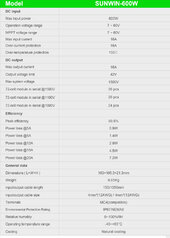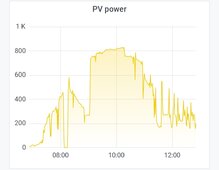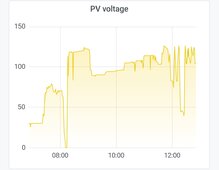meetyg
Solar Enthusiast
- Joined
- Jun 4, 2021
- Messages
- 1,093
Hey all,
I have a somewhat unusual setup and would like to maximize my solar panel output.
Currently I have 4x100w panels (2s2p) and 2x455w panels (not in series or parallel).
I currently have these connected to a grid-tied microinverter, with 4 separate MPPT ports.
But, I now want to connect these panels to my 3k 24v AIO which has a max PV input of 145v (up to 2000w).
I'm ditching the grid-tie because I formally don't have an export contract and thus was just a test setup for learning etc...
Vmp of the 2s2p is around 36v and each of the 455w panels around 42v. Isc for the 2s2p is 5A and 11A for the 455w panels (each).
I would like to connect them in series so that I will be in the sweet spot of the single MPPT on the AIO inverter/charger.
However, as they have different voltages and current ratings (which would limit the efficiency of the overall PV output), I was thinking of using DC optimisers as follows:
1 optimiser for each of the 455w panels, and a third for the 2s2p 400w array. All three will be in series. I was looking at some SUNWIN 600W DC optimisers. These can receive up to 60v at input, and limit the output voltage to 41v. So 41v times 3 = 123v, which sounds good to me. This will also handle any higher VOC due to cooler weather (which is usually 5-10 degrees Celsius at the lowest).
As I understand, DC optimisers will allow each "panel" to output its maximum, while bypassing the delta current to the output, generated by other panels in the string.
Basically, in theory it's as if I had 3 similar panels, but one is constantly shaded.
Am I understanding correctly?
To add complication, the 2s2p is at a different angle (almost 45 degrees) than the 2 x 455w panels (10 degrees) to the sun, but all at the same azimuth.
So in short, will this work well?
My other option was to parallel all 3, but to use blocking diodes between them. But I'm not sure how well that would work out.
Thanks for reading my lengthy question. I would like to hear your thoughts!
I have a somewhat unusual setup and would like to maximize my solar panel output.
Currently I have 4x100w panels (2s2p) and 2x455w panels (not in series or parallel).
I currently have these connected to a grid-tied microinverter, with 4 separate MPPT ports.
But, I now want to connect these panels to my 3k 24v AIO which has a max PV input of 145v (up to 2000w).
I'm ditching the grid-tie because I formally don't have an export contract and thus was just a test setup for learning etc...
Vmp of the 2s2p is around 36v and each of the 455w panels around 42v. Isc for the 2s2p is 5A and 11A for the 455w panels (each).
I would like to connect them in series so that I will be in the sweet spot of the single MPPT on the AIO inverter/charger.
However, as they have different voltages and current ratings (which would limit the efficiency of the overall PV output), I was thinking of using DC optimisers as follows:
1 optimiser for each of the 455w panels, and a third for the 2s2p 400w array. All three will be in series. I was looking at some SUNWIN 600W DC optimisers. These can receive up to 60v at input, and limit the output voltage to 41v. So 41v times 3 = 123v, which sounds good to me. This will also handle any higher VOC due to cooler weather (which is usually 5-10 degrees Celsius at the lowest).
As I understand, DC optimisers will allow each "panel" to output its maximum, while bypassing the delta current to the output, generated by other panels in the string.
Basically, in theory it's as if I had 3 similar panels, but one is constantly shaded.
Am I understanding correctly?
To add complication, the 2s2p is at a different angle (almost 45 degrees) than the 2 x 455w panels (10 degrees) to the sun, but all at the same azimuth.
So in short, will this work well?
My other option was to parallel all 3, but to use blocking diodes between them. But I'm not sure how well that would work out.
Thanks for reading my lengthy question. I would like to hear your thoughts!







